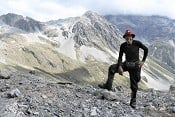In reply to Robert777:
> So I suppose the first question is; have we got enough experience to undertake a trip to the alps?
Yes, provided you suitably limit your aspirations to what is realistic.
The Alps are a huge and varied area, with all sorts of activities possible, including via ferattas (always secured movement up sometimes steep cliffs, with fixed gear, often professionally placed), robust walking, high mountain skiing, lower level technical rockclimbing and of course classical alpinism in the high mountains. So try to pick something that suits your background, which sounds mostly like robust walking.
In the lower Alps (generally up to the level of the mountain refuges where more Alpine routes generally launch from), there are frequent, normally well tracked and mapped paths, you can get pretty high on these, up to 3000m and above without the need to do anything technical. As the other comment said, June, depending on beginning June or end June, is a bit early and you may encounter snow and blocked paths, normally it will be possible to suss out the situation after a couple of outings and avoid likely areas of snowslope.
> Also, what should we expect?
It can be blistering sunshine, walking in shorts/T shirts and possibly trainers or lightweight robust shoes. Or it can be grim, cloudy, dank, with lots of precipitation and strong wind. It depends on the weather and if you are on the North side or South side of the Alps, also how far West in the ranges you are (generally the further East and South, the better the weather.
> can recommend a particular area to visit that would be suitable
One obvious area is the Aosta valley in Northern Italy and its side valleys. Protected by the Mont Blanc and Valaisan ranges from the worst and first of the weather, normally good paths lower down, though they get more stony and nebulous higher up. The popular ice-climbing town of Cogne is the start point for some excellent walks, and like many Italian mountain regions, it has lots of high bivouac huts which you can reach on paths and spend the night in if you wish, without booking or bureaucracy, though you will need to carry food and probably a stove to do so comfortably. Normally it gets very hot indeed in the main Cogne valley at that time of year, so expect to start a walk to the higher side valleys or bivi huts quite early, 7 or 7:30 in the morning, so you can get out of the oven of the main valley before the full heat of the sun arrives.
There are lots of other regions that are delightful to visit at that time of year, such as the Ecrins in France and the Engandine in Switzerland, of for that matter the incredibly stunning views above Zermatt in the Valais region, but for a first trip, Switzerland is probably un-necessarily expensive, though it certainly has some chocolate-box pretty or visually stunning scenes, for example the demanding walk up to the Schreckhorn hut.
You will find in some regions that June is a bit of a hiatus period, especially for the main guardianed refuge huts. They tend to be open around Easter for the ski-touring season, then close in the second or third week in May not to reopen till late June as the main Alpinism season starts. Similarly, campsites and the valleys may be in semi-slumber for the same reason. Quite a popular activity for walkers is to walk up to the guardianed mountain huts by their approach paths, have a beer there and then descend the same day, this is particularly suitable as often you cannot really see the mountains from the main valleys as the valleys are themselves deep and overshadowed, so you need to get up to the next level where the huts are before the main panorama opens up.
Obviously you can't get anything to drink or eat at the huts if they are closed, though of course you can carry it up yourselves. However most of the main mountain huts in a given area have a website these days, which will tell you (sometimes with a bit of frustrating searching), what periods they are open for. Most guardians will also have an email address normally given on the hut site (or the site of the main Alpine club in a country, CAF, Club Alpine Francais in France, CAI, Club Alpin Italian in Italy and SAC, Swiss Alpine Club in CH), usually the guardians are quite helpful in responding. If you don't know the language, either get a friend to translate it or write in English, with an apology for not writing in their native language - it normally gives a better result than pigeon French or German from Google Translate!
Hope that helps









